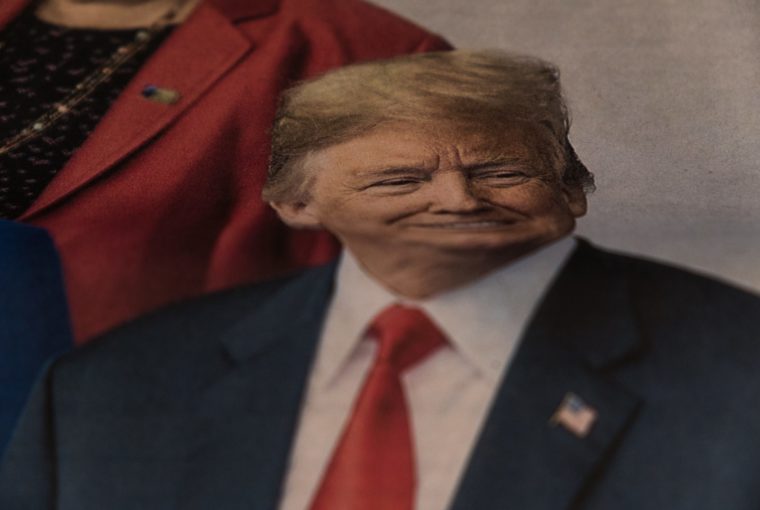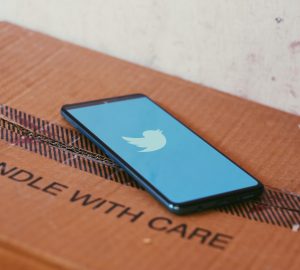The damaged Trump brand may be redeemed among the public, but among journalists, it will be hard.
A survey by the US Press Freedom Tracker project revealed that from June 15, 2015, when Trump declared his candidacy for president, until his last post before having the account suspended by Twitter, on Jan. 8, 2021, he tweeted 24,500 times, with 2,520 posts anti-press tweets.
It means that on average, the former US president tweeted negatively about the press more than once a day for the past 5 ½ years.
It won’t be easy to forgive the man who targeted the media with terms like “Enemy of the People” and “LameStream Media,” and descriptions of the media as “corrupt,” “dishonest” and “hopeless.”
The “Murder the Media” carved into the Capitol building door during the recent protests in Washington can be seen as a result of five years of him undermining the role of journalism.
The U.S. Press Freedom Tracker houses a database of Trump’s anti-media tweets. The report explains that A series of court decisions established that each of those tweets from Trump’s personal handle, @realDonaldTrump, is an official statement from the Office of the President of the United States.
And when Trump tried to circumvent Twitter’s suspension by posting on @POTUS, the official handle for the Office of the President, the social media platform removed those tweets as well. The Trump campaign account, @TeamTrump, was also suspended.
US Press Freedom Tracker found out that in 2020, despite an impeachment process, a global pandemic, widespread national protests against racial injustice and a presidential election that he lost, Trump posted more negative tweets about the media than in any year prior. The report lists 633 anti-press tweet during his fourth and final year in office.
The report says that in the last months of Trump’s presidency, denouncing the press on Twitter took a backseat to attacks against the electoral process, claims of victory and unfounded conspiracy theories of election fraud. And that still, relative to previous years, in his final year in office Trump increased his attacks on specific newsrooms and journalists.
NBC’s Chuck Todd was “honoured” by the former president as the first and the last target of Trump’s tweets against the media. He first insulted NBC’s Chuck Todd on July 12, 2015, referring to the anchor as “pathetic” and that he was “killing Meet the Press.” Almost exactly five and a half years later, on Jan. 6, 2021, Trump targeted Todd in his final anti-media tweet. “Sad to watch!” he posted, using one of his common nicknames for “Sleepy Eyes” Todd.
Not even Fox News escaped. The report found out that, while not in the top three of newsroom targets, the channel followed closely; it had been a favourite target of Trump’s during his candidacy. And saw renewed tweet interest from the president during his final two years in office.
Source: US Press Freedom Tracker database, Trump’s negative Tweets about the press
Trump also dramatically increased on Twitter his references to the media as the “opposition party” or as “partners” of the Democratic party, says the study.
“In contrast to earlier in his presidency, where Trump focused on delegitimizing specific reporting, in his final year in office he increasingly framed the media as a whole as active participants in a conspiracy against him and his administration.”
Trump and the pandemic on Twitter
In its previous report, issued when Donald Trump surpassed 2,000 tweets against the media, US Press Freedom Tracker highlighted that a noticeable uptick occurred as the severity of the new coronavirus progressed throughout the United States, and his administration’s handling of the global health crisis came under increased criticism.
The 2,000th was an example of posts criticising the coverage of no fewer than five outlets and accusing most of bias, if not outright corruption:
The report says that Trump’s negative media tweet rate began accelerating to a pace not seen in the previous 5 months. It rose from 5.6% of his overall tweets in January to 11.2% in March. During the week of March 23 — when the U.S. began to lead the world in confirmed cases — Trump criticized the news media in nearly one in every five tweets.
On March 1, Trump referred to a sweeping number of print and broadcast news outlets as “The Enemy of the People,” a term he first used shortly after taking office. The tweet came one day after the U.S. recorded its first coronavirus death, that of a Washington state man in his 50s.
The Times, The Washington Post, MSNBC, ABC, CBS News and more, he tweeted, “headed” the “Fake News Media” and were a source of national disgust and embarrassment.
The report says that Trump’s anti-press tweets predominantly focused on the media’s coverage of the pandemic and his administration’s response:
“Trump repeatedly condemned the use of unnamed sources, alleged that the media was deliberately dramatising the outbreak to hurt the economy and his reelection chances, and asserted that outlets should unite with him in the face of the crisis, rather than continue covering the outbreak and response critically”.
Twenty tweets targeted specific news outlets, with MSNBC and the Times attacked the most often, and used demeaning “nicknames” like “MSDNC” and “DeFace the Nation.” Five individual journalists — representing four outlets — were also targeted by name.
Rachel Maddow and Joe Scarborough of MSNBC, Chuck Todd of NBC, Maggie Haberman of the Times and Chris Cuomo of CNN, all familiar targets of the president on Twitter, were each singled out at that time.
US Press Freedom Tracker revealed that during his fourth year in office, 14.2% of Trump’s negative tweets about the media have targeted individuals, questioning their legitimacy, ethics and objectivity, as well as insulting their physical appearance or demeanour and assigning them demeaning nicknames.
The press briefings during the pandemic became a war field and were explored by the president on Twitter, reminds the report.
“When ABC’s Chief White House Correspondent, Jonathan Karl, asked during an April 6 briefing about a report from the Department of Health and Human Services inspector general, Trump quipped, “You’re a third-rate reporter.” Karl is also the president of the White House Correspondents Association.”
US Press Freedom Tracker highlights Trump references to CNN as “a JOKE!,” to the Wall Street Journal as “Fake News!” and that he singled out the Post and the Times, asserting that advertising is “WAY down” either because they are “Fake News” or because “the Virus is just plain beating them up.”
Trump also addressed Fox News, tweeting that watching it of weekend afternoons is “a total waste of time.” The report associates this tweet to a report about equipment shortages at the Department of Veterans Affairs and coronavirus-related veteran deaths.
In the previous report, US Press Freedom Tracker stated “the language eroding public trust in the news media, while a hallmark of the president’s administration, has increased on Twitter in tandem with the spread of the coronavirus in the U.S. and criticism of the government’s handling of it”.
It was right, as the perception of the US handling was the worse in the opinion of 75,000 members of the public interviewed by Brand Finance consultancy.
The full report is here.




